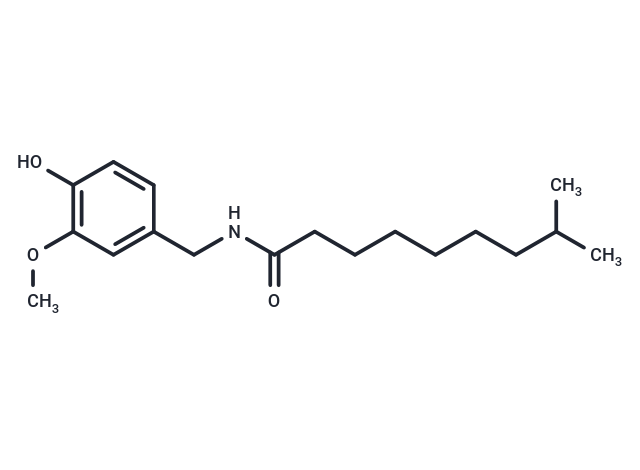 Your shopping cart is currently empty
Your shopping cart is currently empty

Dihydrocapsaicin (CCRIS1589) is isolated from Capsicum fruit. Capsaicin is the primary active component of the heat and pain-eliciting lipid soluble fraction of the Capsicum pepper. Like capsaicin, dihydrocapsaicin is an irritant. Capsaicin is found in natural hot pepper extracts along with a number of impurities, including dihydrocapsaicin and several lesser impurities. Separation by HPLC is required in order to obtain pure dihydrocapsaicin. Dihydrocapsaicin represents about 10% of the compound present in commercial preparations purporting to be pure capsaicin, but it has about the same pungency as capsaicin. VR1 (vanilloid receptor 1) is a heat activated calcium ion channel which functions as a part of the normal nociceptive pain pathway. Capsaicin elicits a sensation of burning pain by activation of VR1 on small, non-myelinated polymodal C-type nociceptive nerve fibers. The potency of dihydrocapsaicin at VR1 appears equivalent to capsaicin. Antioxidant. Reduces oxidation of serum lipids. Mutagenic. Dihydrocapsaicin is an activator of VR1.

| Pack Size | Price | USA Warehouse | Global Warehouse | Quantity |
|---|---|---|---|---|
| 10 mg | $48 | In Stock | In Stock | |
| 25 mg | $97 | In Stock | In Stock | |
| 50 mg | $157 | In Stock | In Stock | |
| 100 mg | $237 | In Stock | In Stock |
| Description | Dihydrocapsaicin (CCRIS1589) is isolated from Capsicum fruit. Capsaicin is the primary active component of the heat and pain-eliciting lipid soluble fraction of the Capsicum pepper. Like capsaicin, dihydrocapsaicin is an irritant. Capsaicin is found in natural hot pepper extracts along with a number of impurities, including dihydrocapsaicin and several lesser impurities. Separation by HPLC is required in order to obtain pure dihydrocapsaicin. Dihydrocapsaicin represents about 10% of the compound present in commercial preparations purporting to be pure capsaicin, but it has about the same pungency as capsaicin. VR1 (vanilloid receptor 1) is a heat activated calcium ion channel which functions as a part of the normal nociceptive pain pathway. Capsaicin elicits a sensation of burning pain by activation of VR1 on small, non-myelinated polymodal C-type nociceptive nerve fibers. The potency of dihydrocapsaicin at VR1 appears equivalent to capsaicin. Antioxidant. Reduces oxidation of serum lipids. Mutagenic. Dihydrocapsaicin is an activator of VR1. |
| Synonyms | CCRIS1589, 8-Methyl-N-vanillylnonanamide, 6,7-Dihydrocapsaicin |
| Molecular Weight | 307.43 |
| Formula | C18H29NO3 |
| Cas No. | 19408-84-5 |
| Smiles | C(NC(CCCCCCC(C)C)=O)C1=CC(OC)=C(O)C=C1 |
| Relative Density. | 1.026 g/cm3 (Predicted) |
| Storage | Powder: -20°C for 3 years | In solvent: -80°C for 1 year | Shipping with blue ice/Shipping at ambient temperature. | |||||||||||||||||||||||||||||||||||
| Solubility Information | DMSO: 247.5 mg/mL (805.06 mM), Sonication is recommended. | |||||||||||||||||||||||||||||||||||
| In Vivo Formulation | 10% DMSO+40% PEG300+5% Tween 80+45% Saline: 2 mg/mL (6.51 mM), Sonication is recommended. Please add the solvents sequentially, clarifying the solution as much as possible before adding the next one. Dissolve by heating and/or sonication if necessary. Working solution is recommended to be prepared and used immediately. The formulation provided above is for reference purposes only. In vivo formulations may vary and should be modified based on specific experimental conditions. | |||||||||||||||||||||||||||||||||||
Solution Preparation Table | ||||||||||||||||||||||||||||||||||||
DMSO
| ||||||||||||||||||||||||||||||||||||
| Size | Quantity | Unit Price | Amount | Operation |
|---|

Copyright © 2015-2025 TargetMol Chemicals Inc. All Rights Reserved.